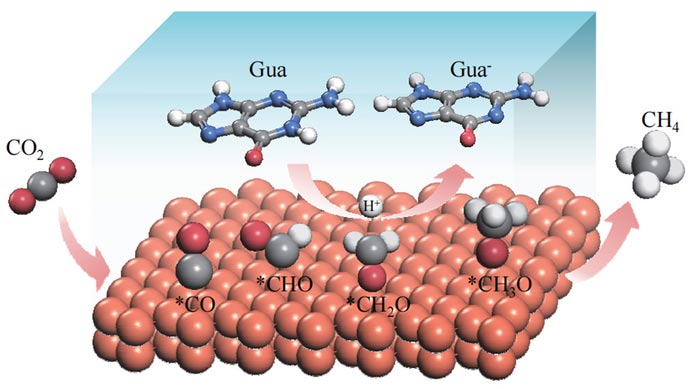Guanine-egulated proton transfer enhances CO2-to-CH4 selectivity over copper electrode

Several purines are modified on Cu electrodes to regulate the surface proton delivery in CO2 reduction. The CH4 production is remarkably enhanced after guanine modification, due to its moderate proton transfer capability.
Credit: Chinese Journal of Catalysis
Electrochemical CO2 reduction is an effective way to realize the artificial carbon cycle and has attracted more and more attention in recent years. Cu is the only metallic catalyst that can realize CO2 deep reduction to various carbonaceous products, but it suffers from low selectivity.
Surface modification is an effective strategy to alter electrochemical CO2 reduction behaviors. Electrochemical CO2 reduction involves multi-step proton-coupled electron transfer processes, so regulating proton transfer has a substantial effect on CO2 reduction pathways.
Inspired by the proton transfer in many biological processes, a research team led by Prof. Lin Zhuang from Wuhan University, China reported “guanine-regulated proton transfer enhances CO2 to CH4 selectivity over copper electrode” recently. They present a well-controlled proton transfer through the surface modification of several purines with similar molecular structures, and reveal a direct correlation between surface proton transfer capability and CO2 reduction selectivity. With a moderate proton transfer capability, the guanine modification remarkably boosted CH4 production and suppressed C2 product formation. In-situ ATR-SEIRAS suggests a weakened *CO intermediate adsorption and a relatively low local pH environment after the guanine modification, which facilitates the *CO protonation and detachment for CH4 generation. The results were published in Chinese Journal of Catalysis (https://doi.org/10.1016/S1872-2067(22)64113-5).
About the Journal
Chinese Journal of Catalysis is co-sponsored by Dalian Institute of Chemical Physics, Chinese Academy of Sciences and Chinese Chemical Society, and it is currently published by Elsevier group. This monthly journal publishes in English timely contributions of original and rigorously reviewed manuscripts covering all areas of catalysis. The journal publishes Reviews, Accounts, Communications, Articles, Highlights, Perspectives, and Viewpoints of highly scientific values that help understanding and defining of new concepts in both fundamental issues and practical applications of catalysis. Chinese Journal of Catalysis ranks among the top two journals in Applied Chemistry with a current SCI impact factor of 12.92. The Editors-in-Chief are Profs. Can Li and Tao Zhang.
At Elsevier http://www.journals.elsevier.com/chinese-journal-of-catalysis
Manuscript submission https://mc03.manuscriptcentral.com/cjcatal
Media Contact
Fan He
Dalian Institute of Chemical Physics, Chinese Academy Sciences
hef197@dicp.ac.cn
Office: 86-411-843-79240
All latest news from the category: Life Sciences and Chemistry
Articles and reports from the Life Sciences and chemistry area deal with applied and basic research into modern biology, chemistry and human medicine.
Valuable information can be found on a range of life sciences fields including bacteriology, biochemistry, bionics, bioinformatics, biophysics, biotechnology, genetics, geobotany, human biology, marine biology, microbiology, molecular biology, cellular biology, zoology, bioinorganic chemistry, microchemistry and environmental chemistry.
Newest articles

High-energy-density aqueous battery based on halogen multi-electron transfer
Traditional non-aqueous lithium-ion batteries have a high energy density, but their safety is compromised due to the flammable organic electrolytes they utilize. Aqueous batteries use water as the solvent for…

First-ever combined heart pump and pig kidney transplant
…gives new hope to patient with terminal illness. Surgeons at NYU Langone Health performed the first-ever combined mechanical heart pump and gene-edited pig kidney transplant surgery in a 54-year-old woman…

Biophysics: Testing how well biomarkers work
LMU researchers have developed a method to determine how reliably target proteins can be labeled using super-resolution fluorescence microscopy. Modern microscopy techniques make it possible to examine the inner workings…





















